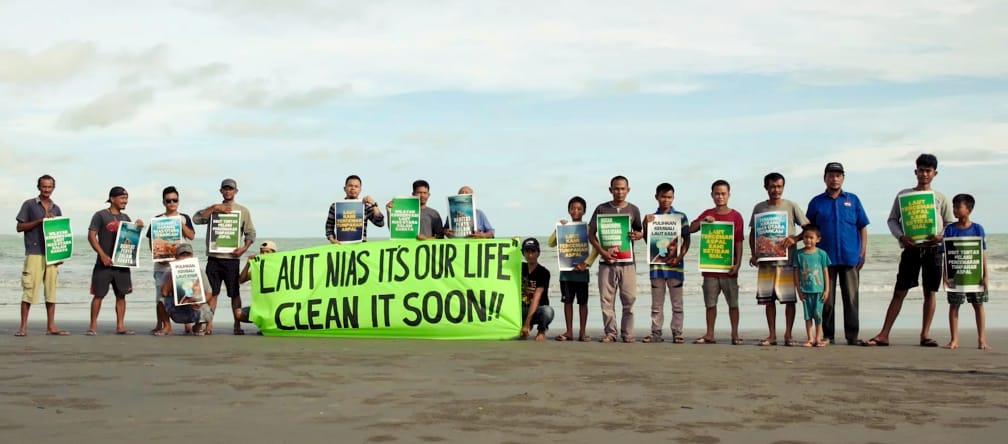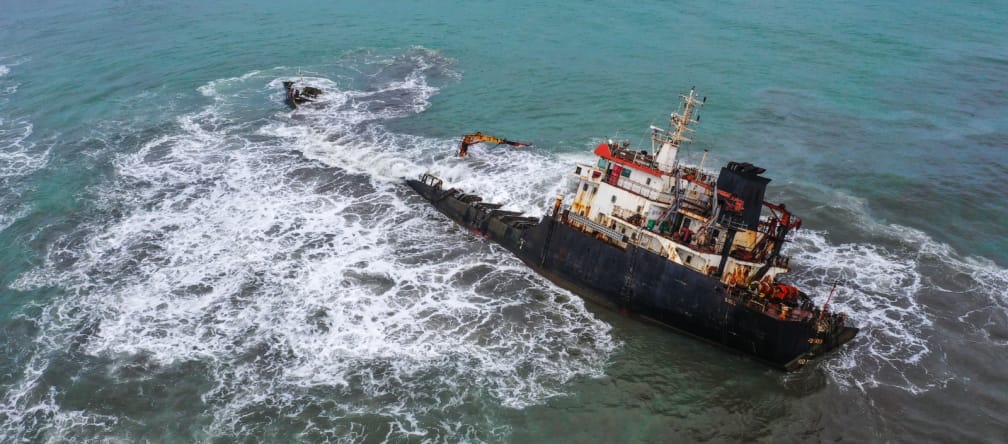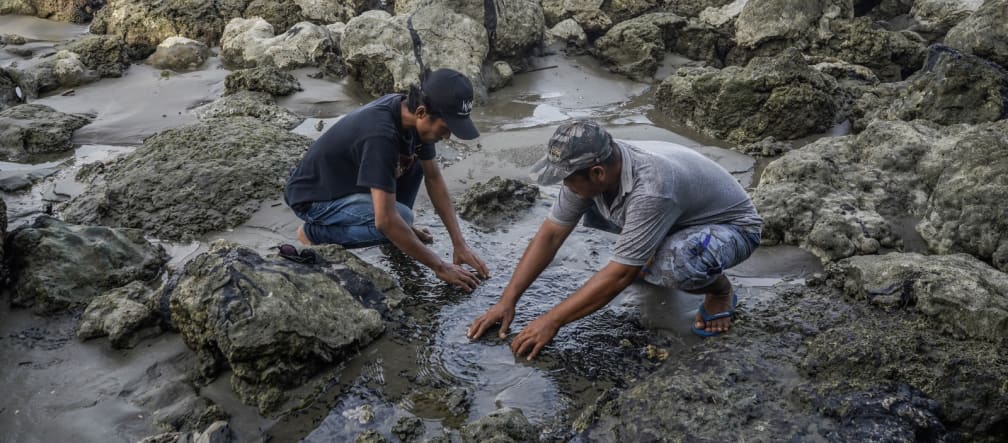Indonesia: Fight the marine bitumen spill off Nias Island!
An environmental disaster is unfolding off the island of Nias: The wreck of the tanker MT AASHI, which ran aground months ago, is leaking bitumen – a sticky, tar-like crude oil byproduct – polluting the waters and damaging coral reefs, mangrove forests and coastlines. Call on the Indonesian government to take action!
To: Government of Indonesia, Government of North Sumatra, MT AASHI
“Take action now to prevent further pollution of the marine environment off Nias!”An environmental disaster is unfolding off the coast of Sumatra: “The coral reefs and mangrove forests all the way to the coast of the island of Nias have already suffered terribly,” explains Rianda Purba, director of the environmental NGO WALHI North Sumatra. "The authorities urgently need to take action. We need the whole world to see what is happening here to ensure that effective measures are taken against the spill.”
In February, the tanker MT AASHI ran aground in the waters between Sumatra and the island of Nias to the west. The ship, flying the flag of Gabon, was carrying 3,600 tons of bitumen from the United Arab Emirates to Sumatra. According to the Ministry of the Environment, the ship was already corroded and was damaged by powerful waves in the Indian Ocean. Bitumen has been leaking and polluting the sea and nearby coastlines since then. The oil slick has now reached a radius of 70 km.
The MT AASHI is designed to carry bitumen. The vessel had a crew of 20 – a captain and sailors from India. The crew was rescued and accommodated by local people. The shipowners have not taken action, however: After ten months, the ship has still not been salvaged and no measures have been taken to clean up the spill.
The people of Nias are asking for our help! Please sign our petition – the international community needs to send a loud and clear signal to the Indonesian government and shipowners.
Pollution of coasts, mangroves and coral reefs
Bitumen is a sticky, black, highly viscous substance that is a crude oil refining byproduct. Following the spill, the coasts are covered with hard, black chunks of tar-like matter. Fishing boats cannot operate in the area because bitumen sticks to the rudders, the nets, the propellers – to everything. The number of fish and birds killed by the spill can only be estimated. Life for the people on Nias and the neighboring islands has turned into a nightmare.
The mangrove forests have been particularly hard-hit: The roots standing in the water are caked with tar, the leaves look scorched, and aquatic life in the mangroves – the nursery of many fish species – is dying off. New mangrove plantations are also impacted.
In marine disasters such as the Exxon Valdez oil spill in Alaska in 1989, hundreds of thousands of seabirds and many other animals were killed. Nature still has not fully recovered there, in part because action was taken far too late.
In the wake of the Exxon Valdez disaster, shipping standards were improved: The International Maritime Organization (IMO) has required double hulls for tankers since 2015. But the new regulations are still not strict enough to prevent terrible disasters from occuring time and again. The transportation of oil remains associated with high risks.
Demands of the people of Nias
* The government is responding far too slowly to the problem of water pollution to the north of Nias. The ship must be salvaged immediately, as bitumen is still leaking from the wreck.
* The massive pollution of the waters off Nias, the coral reefs, mangrove forests and coasts must be cleaned up quickly and thoroughly.
* The mangrove ecosystems must not be exposed to bitumen pollution any longer.
* The economic damage for small fishers is great. Catches have fallen and fishers have to go further out to sea, which costs more fuel.
* Fishers and marine conservation groups must not be left to their own devices. The government needs to act without delay.
The island of Nias
Nias, 125 kilometers west of Sumatra in the Indian Ocean, is a little-known natural paradise. The island was isolated for thousands of years, as can be seen by its distinctive flora and fauna. The islanders are also culturally, linguistically and genetically distinct from the inhabitants of Sumatra. To this day, they live according to the traditions of their Indigenous culture.
Traditional villages are clearly structured. Imposing stone monuments and carved ancestor figures can still be found in some. However, the old, earthquake-proof pile dwellings on hills are becoming increasingly rare.
The tsunami on December 26, 2004 and the Easter 2005 earthquake hit Nias hard and the island has barely recovered. The local people are very poor and rely on fishing. The surfers who used to visit Nias for the impressive waves have not returned since the disasters.
WALHI North Sumatra: “Lara Aspal” video documentary (Indonesian)
To: Government of Indonesia, Government of North Sumatra, MT AASHI
Ladies and Gentlemen,
The tanker accident in February 2023 near the village of Faekhuna’a on the island of Nias, North Sumatra province, resulted in a terrible environmental disaster: Thousands of tons of bitumen are polluting the coasts, coral reefs and mangrove forests. In marine disasters such as the Exxon Valdez oil spill in Alaska in 1989, hundreds of thousands of seabirds and many other animals were killed. Nature still has not fully recovered in Alaska, partly because action was taken far too late. Such a disaster must not happen in Indonesia as well – yet the oil slick now has a radius of 70 kilometers.
Unless immediate and thorough action is taken, the ecological and social effects will be devastating.
We therefore call on you to:
Firstly, salvage the wreck without further delay.
Secondly, empty and clean the wreck thoroughly to prevent further pollution.
Thirdly, take measures to restore the marine ecosystem.
Fourthly, compensate the fishers who have been struck by the disaster and pay compensation for the damage and pollution to the environment.
Fifthly, we call on the government and provinces must take precautions in light of MT AASHI’s handling of the oil spill and form a team capable of responding to such disasters in the future.
Yours faithfully,
According to Marinetraffic, the accident happened on February 11, 2023.


